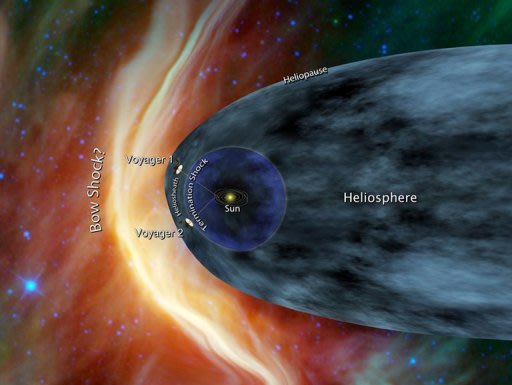NASA's Voyager 1 spacecraft has encountered a "magnetic highway" at the edge of the solar system, a surprising discovery 35 years after its launch, the experts behind the pioneering craft said Monday.
Earlier this year a surge in a key indicator fueled hopes that the craft was nearing the so-called heliopause, which marks the boundary between our solar system and outer space.But instead of slipping away from the bubble of charged particles the Sun blows around itself, Voyager encountered something completely unexpected.
The craft's daily radio reports sent back evidence that the Sun's magnetic field lines was connected to interstellar magnetic fields. Lower-energy charged particles were zooming out and higher-energy particles from outside were streaming in.
They called it a magnetic highway because charged particles outside this region bounced around in all directions, as if trapped on local roads inside the bubble, or heliosphere.
"Although Voyager 1 still is inside the Sun's environment, we now can taste what it's like on the outside because the particles are zipping in and out on this magnetic highway," said Edward Stone, a Voyager project scientist based at the California Institute of Technology, Pasadena.
"We believe this is the last leg of our journey to interstellar space. Our best guess is it's likely just a few months to a couple years away. The new region isn't what we expected, but we've come to expect the unexpected from Voyager."
Voyager is now 11 billion miles (18 billion kilometers) away from the Sun, which is 122 times the distances from the Earth to the Sun. Yet it takes only 17 hours for its radio signal to reach us.
Scientists began to think it was reaching the edge of our solar system two years ago when the solar winds died down and particles settled in space the way they would in a swamp.
An increase in the number of cosmic rays in May also led them to believe Voyager had approached interstellar space.
In July the reading changed again, and by August 25 Voyager was on the magnetic highway. The number of particles from the outside jumped sharply and the number of particles from the inside fell by a factor of 1,000.
"It is as if someone opened the floodgates and they were all moved down the river, also some boaters powered up stream with close to the speed of light have been able to get in at last," said Stamatios Krimigis, Voyager's principal investigator of low-energy charged particles.
While the magnetic field is exciting, Krimigis sounded somewhat disappointed that Voyager had not yet escaped the solar system.
"Nature is very imaginative and Lucy pulled up the football again," he said, making reference to the classic comic strip Peanuts in a conference call with reporters.
The twin Voyager craft -- Voyager 2 was actually launched first, on August 20, 1977, followed by Voyager 1 on September 5 -- were designed primarily to study the biggest planets in our solar system, Jupiter and Saturn.
Taking advantage of a planetary alignment, they fulfilled that mission before pushing on to Uranus and Neptune, beaming back stunning images of the first two in 1979 and 1980, and the latter pair in 1986 and 1989.
But with those jobs complete and both craft still functioning perfectly, project managers decided to keep mining information as the devices fly further into the void.
NASA has described Voyager 1 and its companion Voyager 2 as "the two most distant active representatives of humanity and its desire to explore."
The scientists controlling Voyager 1 -- whose 1970s technology gives it just a 100,000th of the computer memory of an eight-gigabyte iPod Nano -- decided to turn off its cameras after it passed Neptune in 1989 to preserve power.
Assuming the craft continues to function normally, they will have to start turning off other on-board instruments from 2020, and it is expected to run out of power completely in 2025.



Δεν υπάρχουν σχόλια:
Δημοσίευση σχολίου